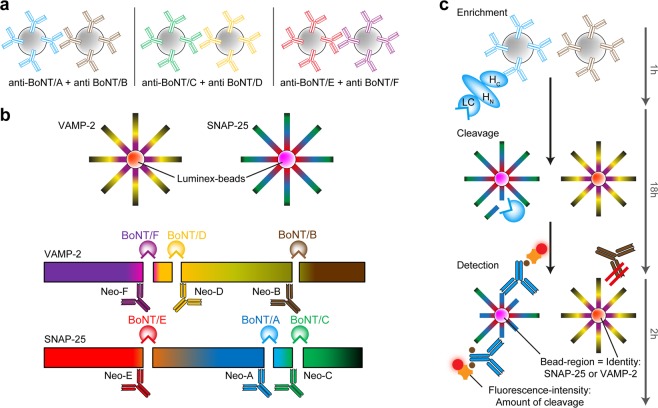Figure 3.
Schematic illustration of the Luminex duplex-assay working principle. (a) Paramagnetic beads coupled to monoclonal anti-BoNT antibodies are added to a toxin containing sample for toxin enrichment. For the three duplex-assays paramagnetic beads containing either anti-A and anti-B, or anti-C and anti-D, or anti-E and anti-F are mixed to enable simultaneous enrichment of two different serotypes in one sample. (b) SNAP-25 and VAMP-2 are coupled to two different regions of Luminex microspheres. Luminex microspheres are paramagnetic beads carrying carboxyl groups to enable coupling of molecules via primary amine groups. Each Luminex bead region carries a distinct ratio of two different fluorescent dyes. Hereby up to 100 colour-coded bead regions can be discerned via their fluorescence emission pattern after excitation. Different BoNT serotypes cleave SNAP-25 or VAMP-2 at distinct, individual sites. The resulting serotype-specific neoepitopes can be detected by Neo-mAbs (Neo-A to Neo-F). The differently coded microspheres for SNAP-25 and VAMP-2 allow for the simultaneous detection of one SNAP- and one VAMP-specific BoNT. (c) Workflow of the duplex-assay exemplarily shown for the BoNT/A + BoNT/B duplex assay with BoNT/A contained in the sample: After enrichment captured toxin is added to VAMP-2 and SNAP-25 coupled Luminex beads where in this case only SNAP-25 is cleaved at the BoNT/A-specific cleavage site. After adding a mixture of Neo-mAbs specific for BoNT/A and BoNT/B, only BoNT/A-specific Neo-mAbs bind to cleaved SNAP-25 immobilised to the colour-coded Luminex-beads enabling specific discrimination between one SNAP-25 and one VAMP-2 cleaving serotype in one assay. The fluorescence-intensity correlates with the amount of cleaved substrate and therefore indicates the concentration of BoNT in the sample.

